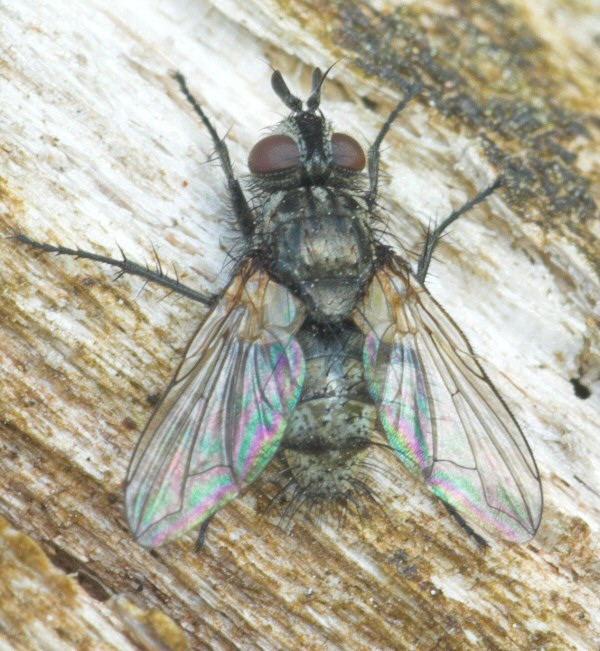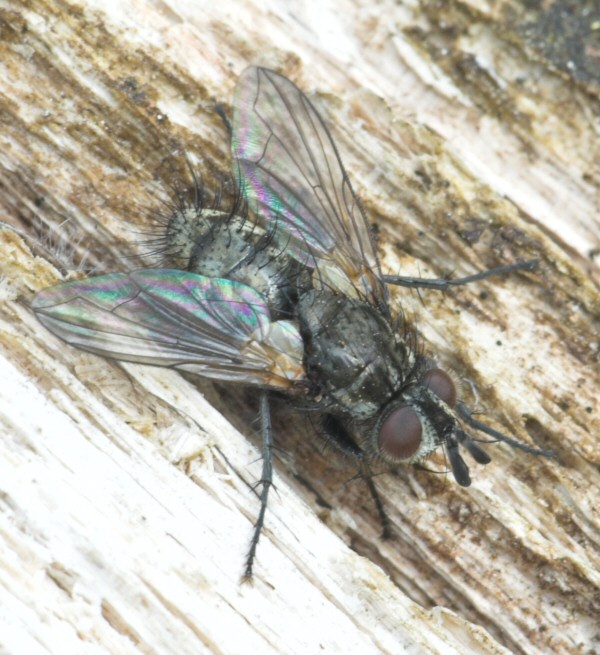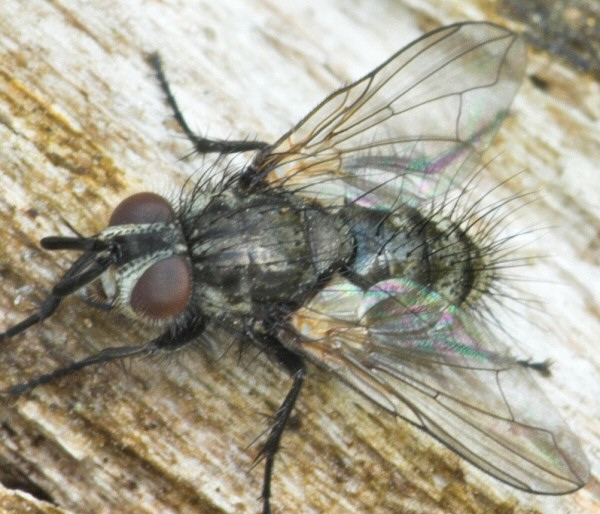Diptera.info :: Identification queries :: Diptera (adults)
|
Tachinidae - Blepharomyia pagana - thanks Theo and Chris
|
|
| tim worfolk |
Posted on 22-04-2010 14:24
|
|
Member Location: Devon, England Posts: 737 Joined: 05.05.09 |
I keyed this one out (very tentatively) as Blepharomyia pagana; can someone confirm or, more likely, correct this? 22/4/2010; Devon, England. thanks Tim tim worfolk attached the following image:  [178.95Kb] Edited by tim worfolk on 25-04-2010 20:42 |
|
|
|
| tim worfolk |
Posted on 22-04-2010 14:25
|
|
Member Location: Devon, England Posts: 737 Joined: 05.05.09 |
more photos if it will help.
tim worfolk attached the following image:  [164.52Kb] |
|
|
|
| tim worfolk |
Posted on 22-04-2010 14:25
|
|
Member Location: Devon, England Posts: 737 Joined: 05.05.09 |
and finally...
tim worfolk attached the following image:  [169.41Kb] |
|
|
|
| ChrisR |
Posted on 22-04-2010 16:46
|
|
Super Administrator Location: Reading, England Posts: 7706 Joined: 12.07.04 |
Do you have a better view of the parafacials? Just from looking at it I would have said Lypha dubia but if it really does have hairy parafacials then ... 
Manager of the UK Species Inventory in the Angela Marmont Centre for UK Biodiversity at the Natural History Museum, London. |
| tim worfolk |
Posted on 22-04-2010 17:14
|
|
Member Location: Devon, England Posts: 737 Joined: 05.05.09 |
slightly better angle on face but not very sharp I'm afraid. Tim tim worfolk attached the following image:  [148.63Kb] |
|
|
|
| ChrisR |
Posted on 22-04-2010 18:24
|
|
Super Administrator Location: Reading, England Posts: 7706 Joined: 12.07.04 |
Hmm, yeah, I am not convinced really ... Lypha is the obvious choice because of the size, colour, time of year & general observable features. The parafacials would be very hard to check from a dorsal and I am thinking we are probably just seeing the top parafacial bristles and we can't see if they really extend lower. Blepharomyia is quite rare here and mine seem to be small and dark in colour, so not like this. 
Manager of the UK Species Inventory in the Angela Marmont Centre for UK Biodiversity at the Natural History Museum, London. |
| Zeegers |
Posted on 22-04-2010 20:24
|
|
Member Location: Soest, NL Posts: 19242 Joined: 21.07.04 |
Are the bristles on the facial ridge or on the parafacial ? It seems the first.... Theo |
|
|
|
| ChrisR |
Posted on 22-04-2010 21:09
|
|
Super Administrator Location: Reading, England Posts: 7706 Joined: 12.07.04 |
I think from this angle it's hard to say ... I didn't think there was enough evidence of a long row of bristles in either case and I would have thought they would be more obvious on something like Campylocheta 
Manager of the UK Species Inventory in the Angela Marmont Centre for UK Biodiversity at the Natural History Museum, London. |
| Zeegers |
Posted on 23-04-2010 08:20
|
|
Member Location: Soest, NL Posts: 19242 Joined: 21.07.04 |
Ocellars are proclinate so Campylochaeta is not an option Theo |
|
|
|
| tim worfolk |
Posted on 25-04-2010 08:36
|
|
Member Location: Devon, England Posts: 737 Joined: 05.05.09 |
I'd ruled out Lypha on the shape of the M-vein (not kinked enough). So if it's not Lypha or Campylochaeta, any other possibilities? Tim Edited by tim worfolk on 25-04-2010 08:37 |
|
|
|
| ChrisR |
Posted on 25-04-2010 08:44
|
|
Super Administrator Location: Reading, England Posts: 7706 Joined: 12.07.04 |
I see what you mean - Ramonda might be a possibility, if it really had bristles down the parafacials. There aren't that many coppery-green, spring-flying tachinids but Ramonda spatulata & Lypha dubia are the commonest here so you could say "possibly Ramonda spatulata", unless Theo objects 
Manager of the UK Species Inventory in the Angela Marmont Centre for UK Biodiversity at the Natural History Museum, London. |
| tim worfolk |
Posted on 25-04-2010 08:52
|
|
Member Location: Devon, England Posts: 737 Joined: 05.05.09 |
Hi Chris - somebody else up too early on a Sunday morning I see  - and thanks for the suggestion, but Ramonda has the same kind of 'kinky' M-vein as Lypha. I'm not sure this is going anywhere - I wish I'd managed better photos - but thanks for trying. - and thanks for the suggestion, but Ramonda has the same kind of 'kinky' M-vein as Lypha. I'm not sure this is going anywhere - I wish I'd managed better photos - but thanks for trying.Tim |
|
|
|
| ChrisR |
Posted on 25-04-2010 09:22
|
|
Super Administrator Location: Reading, England Posts: 7706 Joined: 12.07.04 |
tim worfolk wrote: Hi Chris - somebody else up too early on a Sunday morning I see  Ahh, can't help it in the summer - gets light early and I am up!  Anyway, going over to the BENHS open day at Dinton Pastures later. Am meeting up with Matt Smith & the people from Oxford University to identify some tachinids that were reared out of Small Tortoishell. Expecting a lot of Sturmia and Pelatachina Anyway, going over to the BENHS open day at Dinton Pastures later. Am meeting up with Matt Smith & the people from Oxford University to identify some tachinids that were reared out of Small Tortoishell. Expecting a lot of Sturmia and Pelatachina 
Manager of the UK Species Inventory in the Angela Marmont Centre for UK Biodiversity at the Natural History Museum, London. |
| Zeegers |
Posted on 25-04-2010 19:39
|
|
Member Location: Soest, NL Posts: 19242 Joined: 21.07.04 |
I got a Blepharomyia (pagana) today. The bristles are on the parafacial but very close to the facial ridge. I have little doubt this is Blepharomyia pagana as well (pagana because of the width of the vertex). Theo |
|
|
|
| tim worfolk |
Posted on 25-04-2010 20:41
|
|
Member Location: Devon, England Posts: 737 Joined: 05.05.09 |
Well that's a surprise. I'd sort of given up on ever putting a name to this, but then to find out I was (probably) correct in the first place is a bit of a shock! Thanks to both of you for your help. Tim |
|
|
|
| ChrisR |
Posted on 25-04-2010 20:52
|
|
Super Administrator Location: Reading, England Posts: 7706 Joined: 12.07.04 |
Wow - very good - quite a rare species here - I have never caught one 
Manager of the UK Species Inventory in the Angela Marmont Centre for UK Biodiversity at the Natural History Museum, London. |
| Zeegers |
Posted on 26-04-2010 16:13
|
|
Member Location: Soest, NL Posts: 19242 Joined: 21.07.04 |
get a malaisetrap at the forest edge.... Theo |
|
|
|
| Jump to Forum: |













